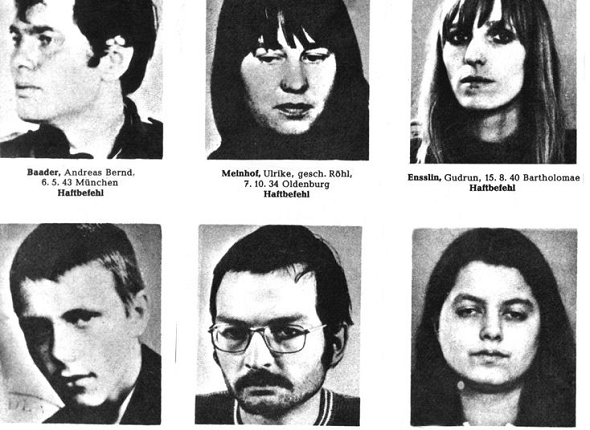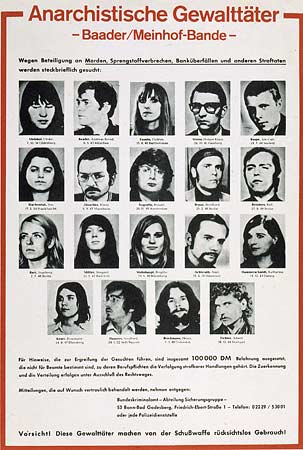A German news magazine has published an encrypted message from a German 1970s terrorist. The solution is known, but some of the details remain unclear.
The far-left terrorist organisation Red Army Faction (RAF) is an integral part of the younger German history. Founded in 1970, this group engaged in numerous bombings, assassinations, kidnappings, and bank robberies, including the killing of notable industry and state representatives such as Alfred Herrhausen (CEO of Deutsche Bank) and Siegfried Buback (Attorney General).
Encryption methods of the RAF
The RAF’s activity peaked in 1977, when the kidnapping of Hanns Martin Schleyer (Director of the Confederation of Employers’ Associations) and of a Lufthansa aircraft led to a national crisis that became known as the “German Autumn”. Altogether, the RAF killed 34 people, while 27 members and supporters lost their lives. The group dissolved in 1998, and meanwhile all RAF activists that went to prison have been released. Some former members of the organization are still on the run.
As far as I know, no one has ever examined the encryption techniques of the RAF in detail. It appears that the terrorists never developed sophisticated cryptographic methods, let alone used these in a systematic way. In this respect, the IRA, the Mafia, and other illegal organizations, reached a higher level.
As I pointed out a few years go in a (German) blog post, the RAF employed many aliases and code terms. Apparently, these basic cryptologic measures fulfilled their purpose by and large. The police struggled to correctly assign the various aliases to the respective persons, with some code names of the third RAF generation still being a mystery.
An RAF cipher
The German news magazine Der Spiegel recently published an encrypted message written by RAF member Adelheid Schulz (thanks to Ralf Bülow for the hint) – a text in cipher, not in code. This note, which describes the location of a hidden weapon and money depot, is the first RAF cipher message I have ever seen. Here it is:
Man steigt in den selben Bus wie zum Rotkehlchen, steigt eine H nach Do/2/1, 2/6, Mir1/4, To2/4, Ul 2/1, 2/3, Ru2/4, 2/1, 2/2, Ol1/1 Do2/3, 2/6, Ol1/2, 1/3, Mir2/1 – anlage aus.
This translates to:
One takes the same bus as to the robin [codename of another RAF depot], gets out one stop after Do/2/1, 2/6, Mir1/4, To2/4, Ul 2/1, 2/3, Ru2/4, 2/1, 2/2, Ol1/1 Do2/3, 2/6, Ol1/2, 1/3, Mir2/1 facility.
Apparently, the encrypted part of this text stands for a bus stop, the name of which has 15 letters. According to Der Spiegel, a police codebreaker named Peter Fleischmann solved this cryptogram. Fleischmann didn’t know the location of the Rotkehlchen (Robin) depot, but he could guess in which area of Germany he had to search.
Fleischmann consulted maps and bus schedules in order to find a bus stop that included the word “Anlage” (“facility”), preceded by a word of 15 letters. He finally found a place named “Müllverbrennungsanlage” (“waste burning facility”) that appeared to fit. MÜLLVERBRENNUNGS has 16 letters, but it later became clear that Schulz had erroneously omitted the second R, which meant that the actual plaintext was MÜLLVERBENNUNGS.
To my regret, the article doesn’t explain the cipher used by Schulz in detail. As it seems, the letters at the start of a cipher group (e.g., “Do”, “Mir”, “Ul”) are codenames of RAF members, with “Mir” representing Schulz herself. The following number (1 or 2) stands for the first or the last name of this person, while the final number denotes the position of a letter in this name.
For instance, “Mir1/4” stands for L, because this is the fourth letter of Schulz’s first name, while “Mir2/1” represents S, the first letter in Schulz’s surname.
Other examples are not given in the article. However, it might be possible to guess some of these. If the cipher description in Der Spiegel is correct, there must have been an RAF member code-named “Do” about whom we know that his or her last name is M*N**U… Does a reader know an RAF activist with such a surname. Can a reader find out other terrorist names that might have bee used for this cipher?
According to Der Spiegel, the breaking of this message led to other RAF ciphertexts being solved. I hope that these will be published one day.
Follow @KlausSchmeh
Further reading: Alessio Vinci’s death and the cryptogram he left behind
Linkedin: https://www.linkedin.com/groups/13501820
Facebook: https://www.facebook.com/groups/763282653806483/




Kommentare (13)